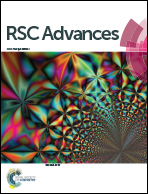Light-controlled switching of the self-assembly of ill-defined amphiphilic SP-PAMAM†
Abstract
Light-responsive amphiphilic spiropyrans-decorated polyamidoamine (SP-P3) with ill-defined structure was prepared by using 3.0G-PAMAM as the scaffold and introducing the spiropyrans to the periphery of it randomly. Under visible light illumination, the ill-defined structure SP-P3 could form an adaptive amphiphilic macromolecule by rearranging dynamically the peripheral amino and SP groups on the surface of PAMAM. The resultant adaptive amphiphilic SP-P3 could hierarchically self-assemble into uniform macrorods about 800–1100 nm in width and 50–80 μm in length. When irradiated with UV light (365 nm), hydrophobic SP-P3 would isomerise into hydrophilic MC-P3, and induced the disassembly of rod-like aggregates. Irradiation with visible light transformed the MC-P3 back to the SP-P3 and then it could re-self-assemble into the rod-like aggregates. These results demonstrated that these macrorods could reversibly disassemble and re-self-assemble in aqueous solution under alternative UV and visible light irradiation. Our experiments not only provide a novel strategy for preparing responsive dynamic materials, but also support the concept that ill-defined amphiphilic macromolecules could also self-assemble to form well-shaped supramolecular structures.


 Please wait while we load your content...
Please wait while we load your content...